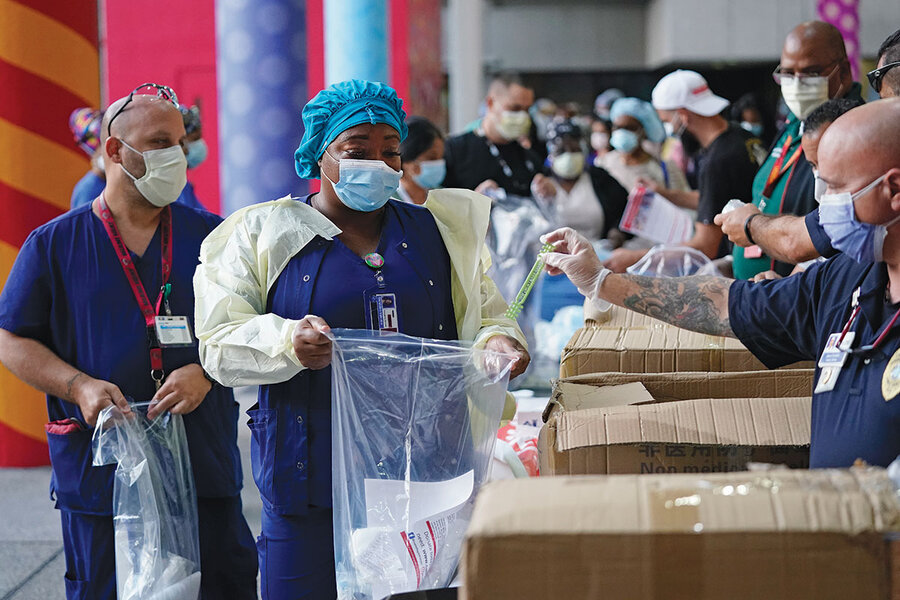Coronavirus spike: Why the US still isn’t prepared
Loading...
In early November the United States became the first nation to see more than 100,000 new COVID-19 cases reported in a single day. The spike has raised questions about America’s ability to combat it.
Despite a new U.S. peak in cases, fatalities remain well below their rate this past spring. Some reasons, researchers say, may include better treatments and precautionary moves by older people who are considered more vulnerable.
Why We Wrote This
A resurgence in coronavirus cases is a nationwide U.S. challenge, especially severe now in rural Plains states. From funding gaps to shortfalls in protective equipment and rural hospital beds, we look at the nation’s readiness.
Yet big challenges remain. One is overcoming the class and race factors that have allowed poor people and people of color to bear the brunt of the pandemic – both as patients and as front-line workers.
The lack of personal protective equipment remains a chronic problem, especially in hot spots for the virus. Smaller hospitals haven’t been able to stock up on gloves and masks as larger hospitals have. And rural hospitals, which have only 1% of the nation’s intensive care beds, now face a surge in patients.
One long-term challenge is unrelated to the pandemic: continuing funding cuts to public health. Once a vaccine is developed and approved, states say $8 billion will be needed for distribution.
The coronavirus has spread from both coasts to the nation’s midsection and in early November the United States became the first nation to see more than 100,000 new COVID-19 cases reported in a single day. The spike has raised questions about America’s ability to combat it.
Q: What have we learned since the spring?
Researchers and government officials have learned a lot about how to battle and control the pandemic since it hit U.S. shores. Social distancing and masking up have become front-line responses. One of the encouraging developments is that, despite a new U.S. peak in cases, new fatalities remain well below their rate this past spring. One reason for this decline is demographic, researchers surmise. The virus is spreading to younger populations, which are considered less vulnerable than older adults.
Why We Wrote This
A resurgence in coronavirus cases is a nationwide U.S. challenge, especially severe now in rural Plains states. From funding gaps to shortfalls in protective equipment and rural hospital beds, we look at the nation’s readiness.
Other likely factors include precautionary moves by older Americans and better treatments. Even at its reduced rate, however, researchers say the pandemic is responsible for roughly 1,000 fatalities per day, six times the average daily toll from the worst influenza season in the past decade.
Q: What are the continuing obstacles?
One challenge is the nature of the virus itself. Estimates vary, but some 20% to 40% of those infected are thought to be asymptomatic – they never exhibit any symptoms. So doctors warn that people can spread it without knowing they have it, making it much harder to trace. Another challenge is public policy. With the number of cases surging to new records, many experts blame the White House for continuing to downplay the threat.
John Auerbach, who heads Trust for America’s Health, a nonpartisan public health policy, research, and advocacy organization, points to a longer-term challenge: continuing funding cuts to public health. For example, two federal initiatives passed after 9/11 to help states prepare for disasters – the Hospital Preparedness Program and the Public Health Emergency Preparedness program – have seen their budgets cut by half and by a quarter, respectively, since 2003, according to TFAH.
Since the Great Recession, cuts in federal, state, and local budgets have also shrunk local public health departments by the equivalent of 26,000 full-time jobs. Once a vaccine is developed and approved, state health departments say an estimated $8 billion will be needed for distribution.
Another challenge: Overcoming the class and racial barriers that have allowed poor people and people of color to bear the brunt of the pandemic – both as patients and as front-line workers, Mr. Auerbach says. “We’re seeing that very clearly in COVID, but this has really been a long-standing phenomenon in health.”
Q: How prepared is rural America?
When the coronavirus first hit, rural America saw little risk. But it has turned out the risks are significant. Hardest hit now is North Dakota, from urban Fargo even to rural Cavalier County on the Canadian border. Geography poses an obstacle, as rural Americans often have to travel quite far to get medical care. Demographics are another. America’s 60 million rural residents are older and are diagnosed with chronic health problems at higher rates than the national average, so they’re considered more at risk from the virus. One other big challenge: health infrastructure. Rural hospitals have only 1% of the nation’s intensive care beds.
And the shortfalls aren’t all in rural areas. The lack of personal protective equipment remains a chronic problem, especially in hot spots for the virus. A U.S. Public Interest Research Group report in late October detailed crucial shortages in nearly 3,000 nursing homes around the country. Smaller hospitals haven’t been able to stock up on gloves and masks as larger hospitals have. Still, compared with the acute shortages last spring, the overall picture appears less bleak. Masks that were next to impossible to find in the spring have become ubiquitous, thanks to entrepreneurs as well as medical-supply specialists.
Enterprising companies have moved into ventilator production, alleviating that crunch. And relief organizations have stepped in to try to get the protective equipment to those who need it most. Since the start of the pandemic, Direct Relief, a California-based aid organization, has shipped more than 43 million masks, 7 million gloves, and millions of other items to health facilities in the U.S. and the world.
Editor’s note: As a public service, we have removed our paywall for all pandemic-related stories.








